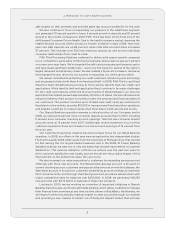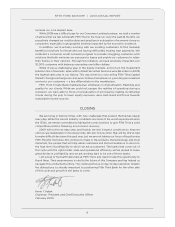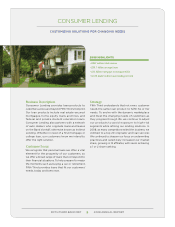Fifth Third Bank 2008 Annual Report Download - page 17
Download and view the complete annual report
Please find page 17 of the 2008 Fifth Third Bank annual report below. You can navigate through the pages in the report by either clicking on the pages listed below, or by using the keyword search tool below to find specific information within the annual report.
MANAGEMENT’S DISCUSSION AND ANALYSIS OF FINANCIAL CONDITION AND RESULTS OF OPERATIONS
Fifth Third Bancorp 15
OVERVIEW
This overview of management’s discussion and analysis highlights
selected information in the financial results of the Bancorp and
may not contain all of the information that is important to you.
For a more complete understanding of trends, events,
commitments, uncertainties, liquidity, capital resources and critical
accounting policies and estimates, you should carefully read this
entire document. Each of these items could have an impact on
the Bancorp’s financial condition, results of operations and cash
flows.
The Bancorp is a diversified financial services company
headquartered in Cincinnati, Ohio. At December 31, 2008, the
Bancorp had $119.8 billion in assets, operated 18 affiliates with
1,307 full-service Banking Centers including 92 Bank Mart®
locations open seven days a week inside select grocery stores and
2,341 Jeanie® ATMs in the Midwestern and Southeastern regions
of the United States. The Bancorp reports on five business
segments: Commercial Banking, Branch Banking, Consumer
Lending, Fifth Third Processing Solutions (FTPS) and Investment
Advisors.
The Bancorp believes that banking is first and foremost a
relationship business where the strength of the competition and
challenges for growth can vary in every market. Its affiliate-
operating model provides a competitive advantage by keeping the
decisions close to the customer and by emphasizing individual
relationships. Through its affiliate-operating model, individual
managers from the banking center to the executive level are given
the opportunity to tailor financial solutions for their customers.
The Bancorp’s revenues are dependent on both net interest
income and noninterest income. For the year ended December
31, 2008, net interest income, on a fully taxable equivalent (FTE)
basis, and noninterest income provided 55% and 45% of total
revenue, respectively. Changes in interest rates, credit quality,
economic trends and the capital markets are primary factors that
drive the performance of the Bancorp. As discussed later in the
Risk Management section, risk identification, measurement,
monitoring, control and reporting are important to the
management of risk and to the financial performance and capital
strength of the Bancorp.
Net interest income is the difference between interest income
earned on assets such as loans, leases and securities, and interest
expense incurred on liabilities such as deposits, short-term
borrowings and long-term debt. Net interest income is affected
by the general level of interest rates, the relative level of short-
term and long-term interest rates, changes in interest rates and
changes in the amount and composition of interest-earning assets
and interest-bearing liabilities. Generally, the rates of interest the
Bancorp earns on its assets and pays on its liabilities are
established for a period of time. The change in market interest
rates over time exposes the Bancorp to interest rate risk through
potential adverse changes to net interest income and financial
position. The Bancorp manages this risk by continually analyzing
and adjusting the composition of its assets and liabilities based on
their payment streams and interest rates, the timing of their
maturities and their sensitivity to changes in market interest rates.
Additionally, in the ordinary course of business, the Bancorp
enters into certain derivative transactions as part of its overall
strategy to manage its interest rate and prepayment risks. The
Bancorp is also exposed to the risk of losses on its loan and lease
portfolio as a result of changing expected cash flows caused by
loan defaults and inadequate collateral due to a weakening
economy within the Bancorp’s footprint.
Net interest income, net interest margin and the efficiency
ratio are presented in Management’s Discussion and Analysis of
Financial Condition and Results of Operations on an FTE basis.
The FTE basis adjusts for the tax-favored status of income from
certain loans and securities held by the Bancorp that are not
taxable for federal income tax purposes. The Bancorp believes
this presentation to be the preferred industry measurement of net
interest income as it provides a relevant comparison between
taxable and non-taxable amounts.
Noninterest income is derived primarily from electronic
funds transfer (EFT) and merchant transaction processing fees,
card interchange, fiduciary and investment management fees,
corporate banking revenue, service charges on deposits and
mortgage banking revenue. Noninterest expense is primarily
driven by personnel costs and occupancy expenses, in addition to
expenses incurred in the processing of credit and debit card
transactions for its customers and merchant and financial
institution clients.
On May 2, 2008, the Bancorp completed the purchase of
nine branches located in Atlanta and deposits of $114 million
from First Horizon National Corporation (First Horizon). On
June 6, 2008, the Bancorp completed its acquisition of First
Charter Corporation (First Charter), a regional financial services
company with assets of $4.8 billion that operated 57 branches in
North Carolina and 2 in suburban Atlanta, paying $31.00 per First
Charter share, or approximately $1.1 billion. On October 31,
2008, the Bancorp assumed approximately $257 million of
deposits from the Federal Deposit Insurance Corporation (FDIC)
acting as receiver for Freedom Bank in Bradenton, Florida.
Earnings Summary
During 2008, the Bancorp continued to be affected by the
economic slowdown and market disruptions. The Bancorp’s net
loss was $2.2 billion, or $3.94 per diluted share, which included
$67 million in preferred stock dividends. Net income was $1.1
billion, or $1.99 per diluted share, for 2007. Results for both years
reflect a number of significant items.
Items affecting 2008 include:
• $965 million of noninterest expense due to a goodwill
impairment charge reflecting the decline in estimated
fair values of certain of the Bancorp’s business reporting
units below their carrying values and the determination
that the implied fair values of the reporting units were
less than their carrying values;
• $339 million and $19 million of net interest income due
to the accretion of purchase accounting adjustments
related to loans and deposits, respectively, from
acquisitions during 2008;
• $273 million of other noninterest income related to the
redemption of a portion of Fifth Third’s ownership
interests in Visa, Inc. (Visa) and $99 million in net
reductions to noninterest expense to reflect the
recognition of the Bancorp’s proportional share of the
Visa escrow account, partially offset by additional
charges for probable future Visa litigation settlements;
• $229 million after-tax impact of charges relating to a
change in the projected timing of cash flows relating to
income taxes for certain leveraged leases. This charge
consisted of approximately $130 million pre-tax,
reflected as a reduction in interest income, and an
increase of approximately $140 million in tax expense
required for interest;
• $215 million reduction to other noninterest income to
reflect the lower cash surrender value of one of the
Bancorp’s Bank Owned Life Insurance (BOLI) policies;
• $104 million reduction to noninterest income due to
other-than-temporary impairment (OTTI) charges on
Federal National Mortgage Association (FNMA) and
Federal Home Loan Mortgage Corporation (FHLMC)
























